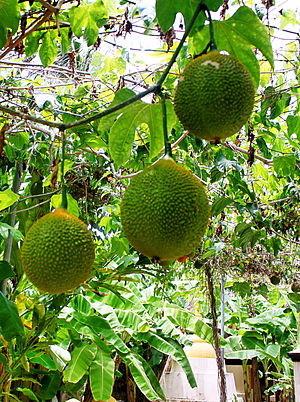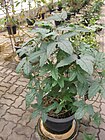Note: This is a project under development. The articles on this wiki are just being initiated and broadly incomplete. You can Help creating new pages.
Difference between revisions of "Momordica cochinchinensis"
| Line 1: | Line 1: | ||
| − | + | [[File:Quả gấc VN.jpg |thumb|right|'''Momordica cochinchinensis''']] | |
| + | '''Momordica cochinchinensis''' is a type of perennial melon grown throughout Southeast Asian countries and Northeastern Australia. Gấc is notable for its orange-reddish color resulting from its rich content of beta-carotene and lycopene. | ||
==Uses== | ==Uses== | ||
| − | {{Uses|}}, {{Uses|}}, {{Uses| | + | {{Uses|wounds}}, {{Uses|skin infections and burns}}, {{Uses|new skin and the healing of wounds}}. |
==Parts Used== | ==Parts Used== | ||
| − | {{Parts Used|}}, {{Parts Used| | + | {{Parts Used|Fruits}}, {{Parts Used|Leaves}}. |
==Chemical Composition== | ==Chemical Composition== | ||
| + | Gac fruit, seeds, and seed oil contain substantial amounts of beta-carotene and lycopene which collectively impart the characteristic red-orange color to the fruit's tissues. Both aril and seeds are rich in monounsaturated and polyunsaturated fatty acids, with oil containing 69% unsaturated fats, including 35% as polyunsaturated fats. Gac has a high concentration of linoleic acid (omega-6) and omega-3 fatty acids. | ||
<ref name="chemical composition"/> | <ref name="chemical composition"/> | ||
==Common names== | ==Common names== | ||
| − | {{Common names | + | {{Common names|kn=|ml=Kshudramalakasanda |sa=Katamala|ta=|te=Varivalli|hi= ककुर Kakur, कंटोला Kantola, ककरोल Kakrol|en=Chinese Cucumber, Spiny bitter-cucumber, Chinese bitter-cucumber}} |
==Properties== | ==Properties== | ||
Reference: Dravya - Substance, Rasa - Taste, Guna - Qualities, Veerya - Potency, Vipaka - Post-digesion effect, Karma - Pharmacological activity, Prabhava - Therepeutics. | Reference: Dravya - Substance, Rasa - Taste, Guna - Qualities, Veerya - Potency, Vipaka - Post-digesion effect, Karma - Pharmacological activity, Prabhava - Therepeutics. | ||
===Dravya=== | ===Dravya=== | ||
| + | |||
===Rasa=== | ===Rasa=== | ||
| − | |||
===Guna=== | ===Guna=== | ||
| Line 29: | Line 31: | ||
==Habit== | ==Habit== | ||
| − | {{Habit|}} | + | {{Habit|Herbs}} |
==Identification== | ==Identification== | ||
===Leaf=== | ===Leaf=== | ||
| − | {{Leaf|||}}<ref name="Leaf"/> | + | {{Leaf|Simple|round in outline|1.5-5.0 cm long and as broad, heart-shaped at base, hairless or sparsely hairy, 3-5-lobed, middle lobes broadly ovate or rhombic-ovate}}<ref name="Leaf"/> |
===Flower=== | ===Flower=== | ||
| − | {{Flower||||}} | + | {{Flower|Bisexual|broadly ovate-heart-shaped|cream white||2.5-3.0 cm across, stalked. Male flowers are solitary, on 1.5 cm long flower-cluster-stalk, bearing near the tip a stalkless}} |
===Fruit=== | ===Fruit=== | ||
| − | {{Fruit|||| | + | {{Fruit|Simple Fruit|ovoid|2-7 cm long, 1-2.5 cm broad|orange-red|}} |
===Other features=== | ===Other features=== | ||
| Line 46: | Line 48: | ||
==Where to get the saplings== | ==Where to get the saplings== | ||
| − | |||
==Mode of Propagation== | ==Mode of Propagation== | ||
| − | {{Propagation|}} | + | {{Propagation|Seeds}}. |
==How to plant/cultivate== | ==How to plant/cultivate== | ||
| + | Maximum insect-aided pollination, the recommended ratio is about 1 male for every 10 female plants. If propagating from vines, farmers make diagonal cut (around 15–20 centimetres (6–8 in) long and 3–6 millimetres (0.1–0.2 in) wide), then root the tubers in water or well-aerated, moist potting media before planting. Apart from Southeast Asian countries where the fruits are native, gac can be grown in sub-tropical climate regions. Cool temperatures inhibit growth. | ||
<ref name="How to plant/cultivate"/> | <ref name="How to plant/cultivate"/> | ||
==Commonly seen growing in areas== | ==Commonly seen growing in areas== | ||
| − | {{Commonly seen| | + | {{Commonly seen|Lowland forest}}. |
==Photo Gallery== | ==Photo Gallery== | ||
<gallery class="left" caption="" widths="140px" heights="140px"> | <gallery class="left" caption="" widths="140px" heights="140px"> | ||
| − | + | File:Exterior and cross-sectional interior of gac.jpg | |
| + | File:Flore des serres v14 227a.jpg | ||
| + | File:Gac Fruit.jpg | ||
| + | File:Gardenology.org-IMG 8003 qsbg11mar.jpg | ||
</gallery> | </gallery> | ||
==References== | ==References== | ||
| + | |||
<references> | <references> | ||
| + | <ref name="chemical composition">[https://en.wikipedia.org/wiki/Gac Chemical composition]</ref> | ||
| − | <ref name=" | + | <ref name="Leaf">[http://www.flowersofindia.net/catalog/slides/Chinese%20Cucumber.html Morphology]</ref> |
| − | + | <ref name="How to plant/cultivate">[https://en.wikipedia.org/wiki/Gac#cite_note-:5-5 Cultivation Details]</ref> | |
| − | |||
| − | <ref name="How to plant/cultivate">[ | ||
| − | |||
</references> | </references> | ||
==External Links== | ==External Links== | ||
| − | * [ ] | + | * [http://www.flowersofindia.net/catalog/slides/Chinese%20Cucumber.html flowers of india] |
| − | * [ ] | + | |
| − | + | * [https://en.wikipedia.org/wiki/Gac Momordica cochinchinensis] | |
| + | |||
| + | |||
[[Category:Herbs]] | [[Category:Herbs]] | ||
| − | [[Category: | + | [[Category:Cucurbitaceae]] |
Revision as of 10:09, 8 June 2020
Momordica cochinchinensis is a type of perennial melon grown throughout Southeast Asian countries and Northeastern Australia. Gấc is notable for its orange-reddish color resulting from its rich content of beta-carotene and lycopene.
Contents
- 1 Uses
- 2 Parts Used
- 3 Chemical Composition
- 4 Common names
- 5 Properties
- 6 Habit
- 7 Identification
- 8 List of Ayurvedic medicine in which the herb is used
- 9 Where to get the saplings
- 10 Mode of Propagation
- 11 How to plant/cultivate
- 12 Commonly seen growing in areas
- 13 Photo Gallery
- 14 References
- 15 External Links
Uses
wounds, skin infections and burns, new skin and the healing of wounds.
Parts Used
Chemical Composition
Gac fruit, seeds, and seed oil contain substantial amounts of beta-carotene and lycopene which collectively impart the characteristic red-orange color to the fruit's tissues. Both aril and seeds are rich in monounsaturated and polyunsaturated fatty acids, with oil containing 69% unsaturated fats, including 35% as polyunsaturated fats. Gac has a high concentration of linoleic acid (omega-6) and omega-3 fatty acids. [1]
Common names
| Language | Common name |
|---|---|
| Kannada | |
| Hindi | ककुर Kakur, कंटोला Kantola, ककरोल Kakrol |
| Malayalam | Kshudramalakasanda |
| Tamil | |
| Telugu | Varivalli |
| Marathi | NA |
| Gujarathi | NA |
| Punjabi | NA |
| Kashmiri | NA |
| Sanskrit | Katamala |
| English | Chinese Cucumber, Spiny bitter-cucumber, Chinese bitter-cucumber |
Properties
Reference: Dravya - Substance, Rasa - Taste, Guna - Qualities, Veerya - Potency, Vipaka - Post-digesion effect, Karma - Pharmacological activity, Prabhava - Therepeutics.
Dravya
Rasa
Guna
Veerya
Vipaka
Karma
Prabhava
Habit
Identification
Leaf
| Kind | Shape | Feature |
|---|---|---|
| Simple | round in outline | 1.5-5.0 cm long and as broad, heart-shaped at base, hairless or sparsely hairy, 3-5-lobed, middle lobes broadly ovate or rhombic-ovate |
Flower
| Type | Size | Color and composition | Stamen | More information |
|---|---|---|---|---|
| Bisexual | broadly ovate-heart-shaped | cream white | 2.5-3.0 cm across, stalked. Male flowers are solitary, on 1.5 cm long flower-cluster-stalk, bearing near the tip a stalkless |
Fruit
| Type | Size | Mass | Appearance | Seeds | More information |
|---|---|---|---|---|---|
| Simple Fruit | ovoid | 2-7 cm long, 1-2.5 cm broad | orange-red | {{{6}}} |
Other features
List of Ayurvedic medicine in which the herb is used
Where to get the saplings
Mode of Propagation
How to plant/cultivate
Maximum insect-aided pollination, the recommended ratio is about 1 male for every 10 female plants. If propagating from vines, farmers make diagonal cut (around 15–20 centimetres (6–8 in) long and 3–6 millimetres (0.1–0.2 in) wide), then root the tubers in water or well-aerated, moist potting media before planting. Apart from Southeast Asian countries where the fruits are native, gac can be grown in sub-tropical climate regions. Cool temperatures inhibit growth. [3]
Commonly seen growing in areas
Photo Gallery
References
External Links
- Ayurvedic Herbs known to be helpful to treat wounds
- Ayurvedic Herbs known to be helpful to treat skin infections and burns
- Ayurvedic Herbs known to be helpful to treat new skin and the healing of wounds
- Herbs with Fruits used in medicine
- Herbs with Leaves used in medicine
- Herbs with common name in Hindi
- Herbs with common name in Malayalam
- Herbs with common name in Telugu
- Herbs with common name in Sanskrit
- Herbs with common name in English
- Habit - Herbs
- Index of Plants which can be propagated by Seeds
- Herbs that are commonly seen in the region of Lowland forest
- Herbs
- Cucurbitaceae




